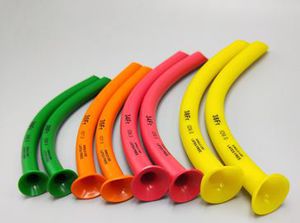
- Primary care
- Emergency medicine, Resuscitation
- Nasopharyngeal intubation cannula
- Hangzhou Formed Medical Devices

- Company
- Products
- Catalogs
- News & Trends
- Exhibitions
Suction cannula intubationnasopharyngeal intubationcurved
Add to favorites
Compare this product
fo_shop_gate_exact_title
Characteristics
- Medical procedure
- suction, intubation, nasopharyngeal intubation
- Form
- curved
- Options
- flexible
Description
Nasopharyngeal airways can be used in some settings where oropharyngeal airways cannot, eg, oral trauma or trismus (restriction of mouth opening including spasm of muscles of mastication). A nasopharyngeal airway device (NPA) is a hollow plastic or soft rubber tubes that a healthcare provider can utilize to assist with patient oxygenation and ventilation in patients who are difficult to oxygenate or ventilate via bag mask ventilation, for example.
Indication:
1. When do you insert a NPA?
Spontaneously breathing patients with soft tissue obstruction of the upper airway.
Sometimes for dilation and anesthesia of the nasal passage to prepare for nasotracheal intubation.
Position
A: The head is flat on the stretcher; the airway is constricted.
B: The ear and sternal notch are aligned, with the face parallel to the ceiling, opening the airway.
2. Instructions For Use
Select correct airway size.
Use universal precautions, such as eye protection, mask, or gloves etc.
Check obstructions of fractures to the nose.
Lubricate the device with a water-soluble gel.
Insert the airway until the flange is resting against the nostril opening.
3. When should nasopharyngeal airway be removed?
If bleeding develops, leave the nasopharyngeal airway in place so long as it does not cause airway obstruction or compromise; otherwise, remove the airway and place the patient in a protective position. PCPs may not suction down the lumen of the nasopharyngeal airway.
Catalogs
No catalogs are available for this product.
See all of Hangzhou Formed Medical Devices‘s catalogsOther Hangzhou Formed Medical Devices products
Nasopharyngeal Airway
Related Searches
- Cannula
- Suction cannula
- Curved cannula
- PVC medical mask
- Endotracheal tube
- Silicone medical mask
- Intubation cannula
- Disposable cannula
- Ambu bag
- Supraglottic airway device
- Oral endotracheal tube
- Injection cannula
- Flexible cannula
- Silicone laryngeal mask
- Manual resuscitator with valve
- Tracheotomy cannula
- Disposable laryngeal mask
- Reusable medical mask
- Manual resuscitator with mask
- Disposable endotracheal tube
*Prices are pre-tax. They exclude delivery charges and customs duties and do not include additional charges for installation or activation options. Prices are indicative only and may vary by country, with changes to the cost of raw materials and exchange rates.




